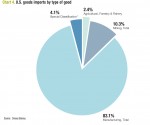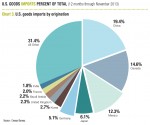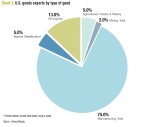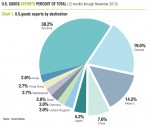Special Section: Primer on U.S. Trade
Manufactured goods rank first among exported products by a wide margin – accounting for 75 percent of total goods exports. The leading manufactured exports are transportation equipment, chemicals, and machinery. Ranked second in exports is re-exported products, totaling up about 13 percent. Re-exports are goods produced abroad, imported into the U.S., and then exported. Among the other export categories, agricultural, forestry & fishing products is tied for third place with special classification products (special classification includes: newspapers, books and other printed matter; printed music and music manuscripts; scrap and waste; used or second-hand merchandise), each making up five percent (Chart 2).
Imports
The U.S. is the world’s largest import destination. The largest single supplier of imports to the U.S. is China, accounting for nearly 20 percent of goods imports. NAFTA countries Canada and Mexico are our second- and third-largest providers of imports, respectively, followed by Japan and Germany. Combined, the top five suppliers of imported goods to the U.S. account for approximately 57 percent of goods imports (Chart 3).
The composition of imported goods is dominated by manufactured goods, accounting for a hefty 83 percent of all imports. The leading manufactured imports are computer and electronic products, transportation equipment, and chemicals. Second on the list is mining products including energy products, accounting for about 10 percent of imports. Special classification goods constitute 4 percent of imports, while agricultural, forestry & fishing products make up the final 2 percent (Chart 4).




